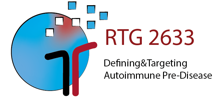MD A14: Impact of different subclasses on immune complex-induced signaling in neutrophils.
Epidermolysis bullosa aquisitia is a severe autoimmune blistering disease that belongs to the group of pemphigoid diseases. As a crucial step in the pathomechanism of EBA, autoantibodies (primarily IgG) target type VII collagen, an adhesion protein of the dermal-epidermal junction (DEJ)1.
Pathogenic immune complexes (ICs) consisting of the autoantigene type VII collagen and autoantibodies (e.g. IgG1-4) induce activation of neutrophils by activating Fcγ receptors (FcγRs)2.
The extent of the subsequent signalling is affected by different subclasses and glycosylation patterns of the IgG antibodies. As a result of their activation, neutrophils release reactive oxygen species (ROS) which directly contribute to split formation at the DEJ and therefore skin blistering.
The overarching aim of my project is to identify kinase signatures and cellular functions in neutrophils activated with different IgG subclasses and glycosylation patterns. In the context of autoimmune pre-disease, knowledge of the exact impact of the different IgG subclasses on the kinome and the effector function of neutrophils can help to understand the outbreak of the disease and to find possibilities to circumvent it.

- Projects
- A: Defining Autoimmune Pre-Disease
- B: Targeting of Autoimmune Pre-Disease
- Associated projects
- MD projects
- Associated MD projects
- Concluded Projects
- PhDs
- Ass. projects
- MDs
- MD A1 - Investigation of the influence of specific CDK inhibitors on neutrophil activation
- MD A2 - Conception of an anatomical expression of landscape of target antigens in autoimmune blistering dermatoses as markers for lesion formation
- MD A3 - Structural characterization of skin-directed autoantibodies and their interaction with the antigen to gain insights into autoimmune pre-disease
- MD A4 - Do interactions between AT1R autoantibodies derived from patients with systemic sclerosis and endothelial cells lead to endothelial dysfunction?
- MD A5 - Optimization and exploitation of a 3D model of human skin for translational use
- MD A6- To study vasculopathy in systemic sclerosis
- MD A7- Identification of autoantibodies contributing to the break of immunotolerance in immunization induced MMP mouse model
- MD A8- The role of AT1R antibodies and extracellular vesicles in mediating endothelial dysfunction in systemic sclerosis with pulmonary arterial hypertension
- MD A9- Impact of glycosylation on IgG4-induced signaling in neutrophils
- MD A10- Testing a new single chain variable fragment for pemphigus foliaceus in the human skin organ culture model
- MD A11- Impact of glycosylation on IgG3-induced signaling in neutrophiles
- MD A12- Screening for inhibitors to prevent keratinocytes dissoziation
- MD A13- Investigation of the local and systemic complement activation in bullous pemphigoid
- MD A14 - Impact of different subclasses on immune complex-induced signaling in neutrophils.
- MD A15 - Novel target antigens as inducers of autoimmunity of autoimmune bullous dermatoses
- MD A16 - Identification of the major epitope of the BP180 ectodomain recognized by serum IgA autoantibodies of patients with pemphigoid diseases –IgA autoantibodies as prognostic marker?
- MD A19 - Role of Staphylococcus aureus on immunogenic cell death induction in autoimmune vasculitis
- MD B1 - Testing the effect of kinase inhibitors in the human skin organ culture model
- MD B2 - Cigarette smoking-induced autoantibodies
- MD B3 - Contribution of taurine, hypoxanthine, vitamin B5 and B6 in the pathomechanism of pemphigus vulgaris
- MD B5 - Molecular characterization of the pre-autoimmune effects of Western diet in healthy mice
- Ass MDs







